Can Jacobs advance at Kona?
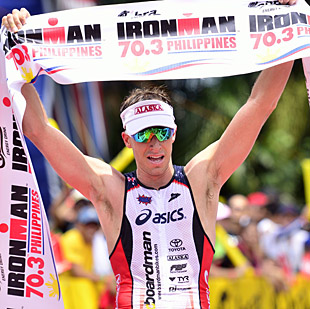
Pete Jacobs quietly knocked on the door of Kona stardom in 2009 when he finished 8th. He knocked a little louder in 2010 when he ran 2:41:05 — the third-fastest marathon in Kona history and fastest on the day — while finishing 9th despite serving a 4-minute penalty on the bike. Last year, Jacobs insisted he belonged among the elite few who had a realistic chance of Kona victory when he finished runner-up to Craig Alexander in a time of 8:09:11 – a few seconds faster than Mark Allen’s 1989 Iron War winning time. Once again, Jacobs posted the fastest run of the day with a 2:42:29.
For a man who regularly posts the fastest swim and the fastest run, Jacobs made big progress last year at Kona with a 4:31 bike split. Still he gave away 7 minutes to Crowie and the serious contenders, a deficit he has worked hard to correct this year with the help of the legendary cyclist Chris Boardman, the manufacturer of Jacobs’ Boardman bike.
This season, after making several public appearances thanks to his growing Kona reputation, Jacobs hit some injury-related speed bumps. After a 6th at Urban Hotels long course and a win at the Huskisson Long Course in February, Jacobs was struck with a pinched nerve in his hip and glute. After he limped back to rehab, he did not compete until June when he won Ironman 70.3 Cairns. But after that highlight, his bumpy, up-and-down year continued with a 4th at Ironman 70.3 Syracuse, a 6th at New York City 5150, a distant 2nd at Ironman Lake Placid, followed by a reassuring win at Ironman 70.3 Philippines.
While outsiders may lose their faith that Jacobs can top his 2011 Kona finish, Jacobs is not discouraged, asserting that he has thrived after a similar injury time out early in each of the past three seasons. Jacobs was interviewed via email this week.
Slowtwitch: As the defending 2nd place finisher and two-time fastest runner at Ironman Hawaii, you are no longer a stealth contender. How much pressure do you feel as one of the key men carrying the Australian flag at the Ironman World Championship in 2012?
Pete Jacobs: I don't feel any pressure to continue the Australian winning streak from Craig Alexander and Chris McCormack. I see them as my biggest competition. With my past results in Hawaii I know there are many people (Australians and others) wishing me well and believing that I can win it. I believe it too. However I don't feel this as pressure. This is my journey, and in a race which is so long and unforgiving, I'm not worried about my other competitors. I just want to do something extraordinary for my own satisfaction. My own dreams are greater than anyone else's expectations so if I have a poor race I'm only disappointing myself. The pressure from other people does not compare.
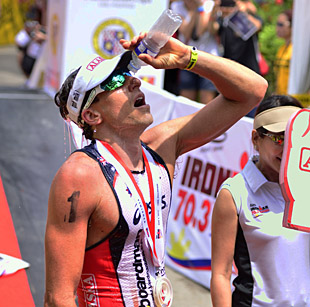
ST: After the your win at the Huskisson Long Course Triathlon in February, you were limping with a pinched nerve at your glute and hip and had to back out of a highly anticipated date at Ironman Melbourne. What were the ramifications of that injury?
Pete: Long story. I'd first felt my third metatarsal in my left foot drop down and strike the ground prominently, and therefore risking a stress fracture, in mid-January. It had dropped somehow, and no one could tell me when/how/if it could be fixed back into line with the others. I did some foot exercises and barely ran as I trained haphazardly for a couple of races, which worked out OK with a win in Huskisson in mid February. My glute and hip now became the problem and I did not train for a couple of weeks. So I decided around this time to pull out of Melbourne Ironman – the pressure of racing an Ironman while overcoming injury, is too much to focus on and everything suffers mentally and physically. I also had no idea how long it would take for me to feel normal. A few different physios looked at me and were no help, but one persisted on looking outside the box and found my ribs were twisted. Releasing my ribs helped a lot and pressure returned to my feet, momentarily. I also had poor rotation in my right leg and a tight adductor also caused problems. The next physio was an ART [Active Release Techniques] guy and with information about my ribs helping he saw that my shoulder was stuck hunched forward slightly. A few releases and a week of exercises and I was back to normal. I continue with these exercises to improve movement through my mid and upper thoracic spine. It's funny how my foot problem was not a foot problem at all.
ST: What have been some of your key rehab exercises? How much improvement have they made?
Pete: They are simple twisting exercises, along with basic movements to connect arm, shoulder, hip, glute and leg. Just firing the muscles and switching them on at the same time as others is the key. They have got me back to normal, and continuing to do them I think will get me in better shape than before. I used to get pins and needles in my right hand doing some movements, but that is all gone now and the nerves are lengthening.
ST: How long has this rehab gone on? And how much remains to be done?
Pete: It took months and dozens of appointments to find the answer but once found, everything righted itself immediately. As for ongoing, I only do 15 minutes every few days and that's keeping me in good shape. I will try to do it more often now the km's are ramping up towards Hawaii.
ST: You wanted to race Lance Armstrong at Kona 70.3, but that was canceled. What stage were you before you canceled?
Pete: I think I was training, and things were fixed, but I had barely run in months and didn't want to add the pressure of overcoming an injury to racing Lance and Greg Bennett. About a month before the race I decided a home race was much easier as that also gave me a couple more weeks to plan my trip to USA for the Ironman (I still had to validate my qualification for Hawaii).
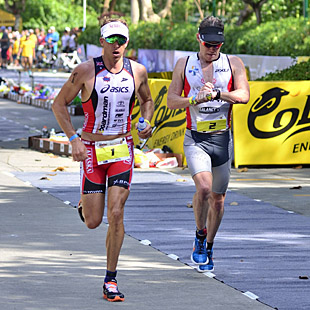
ST: Are there lessons to be learned from these accumulated physical woes that struck you after your greatest race last year?
Pete: I have learnt a little more about how the body works. Thinking I had a foot problem, which disappeared when I pulled my opposite shoulder back – that just blew my mind how much the muscles are connected and rely on one another. It reinforced to me that it's not about how many km's you do in training, it's about how efficiently you do them.
ST: What did you learn about yourself during all your personal appearances and speeches after Hawaii about your strategies for mental focus, your motivation?
Pete: I've learnt a little about how people do say things against you, just because you are doing well. Macca has had to deal with it a lot and I got just a small taste of it, but it hurt a lot at first. The second time I let it go, and realised that some people will take things I say the wrong way, others will make up their opinion about me before we've even met, and some will just not like me because I'm not perfect. This helped to centre my focus back on myself, and remember why I want to win the World Championship – because I want to do it for myself. Because this will make me happy.
ST: When did you know you were ready to train hard and compete again before Ironman 70.3 Cairns? How close to 100 percent were you at that time?
Pete: I had been riding really well for months leading up to this week of the race, but my running was only just building. I rode the best 90km I've ever ridden in Cairns 70.3, but I struggled on the run. Yes, it is easier to ride well when run training is minimal, but I still was a little behind a total 100%.
ST: Could you recall the incredible travel odyssey you went through to race Syracuse 70.3? And how it affected your performance?
Pete: Jaimie [his wife] and I headed from Noosa to New York on the Saturday. After a great night at the Urban Hotel Brisbane, and a stopover in Korea, we got to bed on the east coast of the US at 1:30 AM Monday morning. We rode the next few days in mid 90 degree heat, then drove the 5 hours up to Syracuse. There I fell apart on the bike, and struggled to keep myself moving forward mentally and physically. Jaimie cramped on the run and was in the medical tent for 45 minutes (until they finally conceded and gave her an IV saline drip). At this point I conceded that the travel had dehydrated us massively and we hadn't recovered.
ST: Given what you went through, did that struggle just to get there take
away any anxiety you might have felt for a substandard (for you) 4th place finish?
Pete: I'm OK with having bad races. I always have reasons (excuses) and learn something from them. Learning about how hard it is to adjust to being on the opposite side of the world was one, travel and dehydration was another.
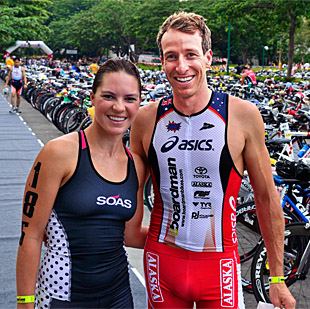
ST: Given what you went through, did that struggle just to get there take away any anxiety you might have felt for a substandard (for you) 4th place finish?
Pete: I'm OK with having bad races. I always have reasons (excuses) and learn something from them. Learning about how hard it is to adjust to being on the opposite side of the world was one, travel and dehydration was another.
ST: Anything to be encouraged about?
Pete: I still ran an OK time [4:01:10, 7 minutes back of Joe Gambles] despite feeling very average, and we made some great friends with our home stay couple.
ST: How much of a shocker was sit to feel your arms were dead on the IM Lake Placid swim and finishing 2nd, 31 minutes back of Andy Potts?
Pete: It was disappointing when I felt buggered halfway through the swim, but it's a long day, and sometimes I come back from feeling bad. But it wasn't surprising. We had had trouble finding a pool to swim at near where we were staying in New Jersey. And with all the travelling and the New York Tri 5150 two weeks after Syracuse and two weeks before Lake Placid, I hadn't been all the consistent at getting in the pool — nothing over 2000 yards.
ST: Same question about the bike?
Pete: This was tough to take. I had been riding so well before leaving Australia, and had some good rides in New Jersey. Again, nothing long though (3-4 hours was my best), but I fell apart early at about 30 miles. In hindsight I put this down to long term dehydration. I just couldn't get going with any strength.
ST: Analyzing your race afterward, what caused this?
Pete: I'm still working on my tapering for my bike. I often feel great a week before the race then feel flat on race day. It may just be that when I don't have any strength (I haven't done the km's in training) in the swim my body tightens up and slows me down on the ride. And second my previous comments about travel and dehydration as well. It highlighted how much dehydration can affect performance and that I need to manage it better pre race. I've had a couple of long chats since with Darryl from Shotz, my nutrition sponsor, and he's once again helping me prepare in a smarter and more confident way for Kona.
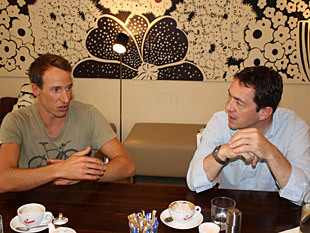
ST: Back to off season. How much did Chris Boardman help you with advice on your bike positioning, training and strategy?
Pete: He reinforced my previous ideas about quality not quantity. His comments about aerodynamics were a great comfort also. He didn't suggest how to train for a 180 kilometer time trial in the middle of an Ironman and said he wouldn't know what that's like. But he suggested a couple of sessions which I repeated many times in my lead up to Cairns 70.3.
ST: Tell us about all your support crew who have helped you through this rehab?
Pete: I just go about it myself mostly, finding the physios, etc. My manager Evan Gallagher helped relieve the pressures by first suggesting I don't race the high pressure races until I'm 100%. And my sponsors were great. They don't care if I don't race until I'm 100%, and whenever/wherever is best for me and Hawaii.
ST: After all your misadventures, might this time off have been an unintended blessing giving your body some rest after several seasons of intense,
uninterrupted work?
Pete: Absolutely. I've had a forced break though injury the last 3 years now, and Hawaii has worked out well every time. I'm still learning so much about my body, and at 30 years old I have a long time left as the older Australians have shown recently. It is an art, as much as a science to balance everything for the demands of Kona. And the injuries help remind me of that.
ST: Are all the pieces in place – and do you have enough time — for you to be ready for a great performance at Kona again?
Pete: My injury was much earlier this year than previous years and I'm running now as I was for Hawaii last year. I'm a couple of months ahead in my running prep. I fell apart in the last 10km last year, but with the extra kilometers of training I've put into my legs I don't think that will happen this year. Now I just need to work on the bike a lot over the next 2 months, and have my nutrition and electrolyte balanced even better than last year, and survive the heat of Kona again. So yes, I have plenty of time to be in a good position for the opportunity for a better performance.


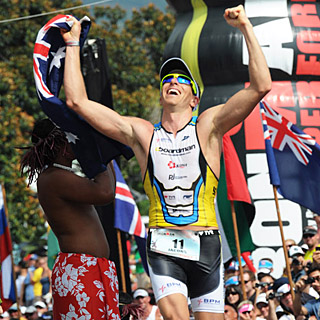
Start the discussion at slowtwitch.northend.network